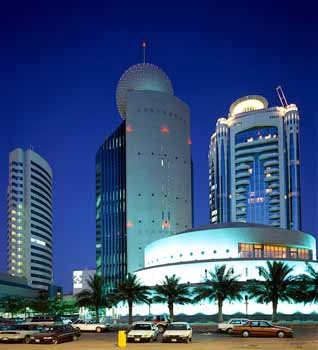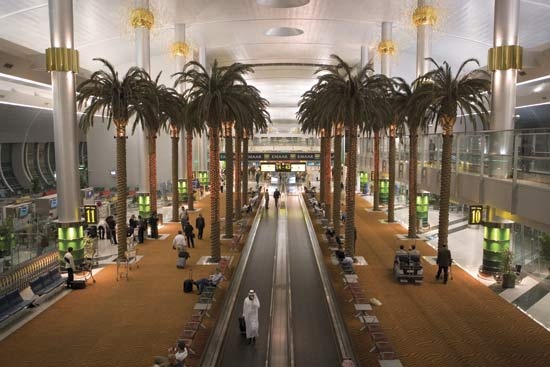Dubayy
emirate, United Arab Emirates
also spelled Dubai
 constituent emirate of the United Arab Emirates (formerly Trucial States or Trucial Oman). The second most populous and second largest state of the federation (area 1,510 square miles 【3,900 square km】), it is roughly rectangular, with a frontage of about 45 miles (72 km) on the Persian Gulf. Dubayy's capital, Dubai, the largest city of the federation, is on a small creek in the northeast part of the state. More than nine-tenths of the emirate's population lives in the capital and nearby built-up sections. Dubayy is surrounded by Abū Ẓaby emirate on the south and west and by Al-Shāriqah (Shāriqah, Al-) emirate on the east and northeast. In addition, the small exclave (detached section) of Al-Ḥajarayn in the Wadi Ḥattá, more than 25 miles (40 km) from the nearest territory of Dubayy proper, belongs to the state.
constituent emirate of the United Arab Emirates (formerly Trucial States or Trucial Oman). The second most populous and second largest state of the federation (area 1,510 square miles 【3,900 square km】), it is roughly rectangular, with a frontage of about 45 miles (72 km) on the Persian Gulf. Dubayy's capital, Dubai, the largest city of the federation, is on a small creek in the northeast part of the state. More than nine-tenths of the emirate's population lives in the capital and nearby built-up sections. Dubayy is surrounded by Abū Ẓaby emirate on the south and west and by Al-Shāriqah (Shāriqah, Al-) emirate on the east and northeast. In addition, the small exclave (detached section) of Al-Ḥajarayn in the Wadi Ḥattá, more than 25 miles (40 km) from the nearest territory of Dubayy proper, belongs to the state.The settlement of Dubai town is known from 1799. The sheikh (Arabic: shaykh) of Dubayy, then a minor, signed the British-sponsored General Treaty of Peace (1820), but the area was seemingly dependent on Abū Ẓaby until 1833. In that year, a group of Āl bū Falāsāh clansmen of the Banī Yās, chiefly pearl fishers, left Abū Ẓaby in a rivalry dispute and took over Dubai town without resistance. From then on, Dubayy became, by local standards, a powerful state and was frequently at odds with its former rulers. The Qawāsim pirates tried to take control of Dubayy, but its rulers retained their independence by playing the neighbouring sheikhdoms against each other. Together with the rest of the original Trucial States, Dubayy signed with Britain a maritime truce in 1835 and the Perpetual Maritime Truce in 1853. Its foreign relations were placed under British control by the Exclusive Agreement of 1892. When Britain finally left the Persian Gulf in 1971, Dubayy was a prominent founding member of the United Arab Emirates.
The sheikhs of Dubayy, unlike most of their neighbours, long fostered trade and commerce; Dubai was an important port by the beginning of the 20th century. Many foreign merchants (chiefly Indians) settled there; until the 1930s it was known for pearl exports. More recently, Dubai (including its twin city and commercial centre, Dayrah, on the opposite side of the creek) has become the region's chief port for the import of Western manufactures. Most of the United Arab Emirates' banks and insurance companies are headquartered there. After the devaluation of the Gulf rupee (1966), Dubayy joined the country of Qatar in setting up a new monetary unit, the riyal. In 1973 Dubayy joined the other emirates in the adoption of a national currency, the dirham. Dubayy has free trade in gold, and there is a brisk smuggling trade in gold ingots to India, where gold imports are restricted.
In 1966 the offshore oil field of Fatḥ (Fateh) was discovered in the Persian Gulf about 75 miles (120 km) due east of Dubai, in waters where the state had granted an oil concession. By the 1970s three 20-story submarine tanks, each holding 500,000 barrels, were installed on the seabed at the site. Shaped like inverted champagne glasses, they are popularly called the “Three Pyramids of Dubayy.” Dubayy's estimated oil reserves are less than one-twentieth those of neighbouring Abū Ẓaby, but oil income combined with trading wealth has made Dubayy a very prosperous state. A number of industrial plants, including an aluminum smelter and an associated natural gas fractionator, were built in the late 1970s near Dubai. Since the late 1980s aluminum production has greatly increased through a number of staged expansions of the smelter's facilities.
 Dubayy has concentrated on a wide range of development and construction plans designed to promote tourism, transport, and industry. Port Rāshid (a deepwater harbour named for the emir) was opened there in 1972, and a supertanker dry dock was completed in 1979. In an effort to boost industrial investment, the Jabal ʿAlī (Jebel Ali) port and industrial centre was declared a free-trade zone in the early 1980s; the move was largely successful, and numerous international companies responded favourably by opening facilities there. The project of overseeing Port Rāshid and Jabal ʿAlī was taken over by the Dubai Ports Authority in the early 1990s, which was created for the task. Dubayy is served by the Dubai International Airport, and Emirate Airlines, the national carrier of the United Arab Emirates, was established by the Dubayy government in the mid-1980s.
Dubayy has concentrated on a wide range of development and construction plans designed to promote tourism, transport, and industry. Port Rāshid (a deepwater harbour named for the emir) was opened there in 1972, and a supertanker dry dock was completed in 1979. In an effort to boost industrial investment, the Jabal ʿAlī (Jebel Ali) port and industrial centre was declared a free-trade zone in the early 1980s; the move was largely successful, and numerous international companies responded favourably by opening facilities there. The project of overseeing Port Rāshid and Jabal ʿAlī was taken over by the Dubai Ports Authority in the early 1990s, which was created for the task. Dubayy is served by the Dubai International Airport, and Emirate Airlines, the national carrier of the United Arab Emirates, was established by the Dubayy government in the mid-1980s. In the early 21st century a range of transportation and construction projects were underway, including light- and urban-rail systems, a sports complex, luxury hotels, and island developments. Construction on Dubai's prized Burj Dubai (“Dubai Tower”)—though interrupted by strikes held by the city's large population of expatriate labourers—continued in 2007, when the then still-incomplete landmark became both the world's tallest building and its tallest freestanding structure. Pop. (2005 est.) emirate, 1,200,309.
In the early 21st century a range of transportation and construction projects were underway, including light- and urban-rail systems, a sports complex, luxury hotels, and island developments. Construction on Dubai's prized Burj Dubai (“Dubai Tower”)—though interrupted by strikes held by the city's large population of expatriate labourers—continued in 2007, when the then still-incomplete landmark became both the world's tallest building and its tallest freestanding structure. Pop. (2005 est.) emirate, 1,200,309.- Blum, Léon
- Blunden, Edmund Charles
- blunderbuss
- Blunt, Anthony
- Bluntschli, Johann Kaspar
- Blunt, Wilfrid Scawen
- Bly, Nellie
- Bly, Robert
- Blytheville
- Blyth Valley
- Blyton, Enid
- Blériot, Louis
- Blériot XI
- Blücher, Gebhard Leberecht von, Prince Von Wahlstatt
- B'nai B'rith
- BND
- BNP Paribas
- Bo
- boa
- Boaco
- boar
- Boardman, Mabel Thorp
- Boardman Robinson
- Board of Trade
- Board on Geographic Names